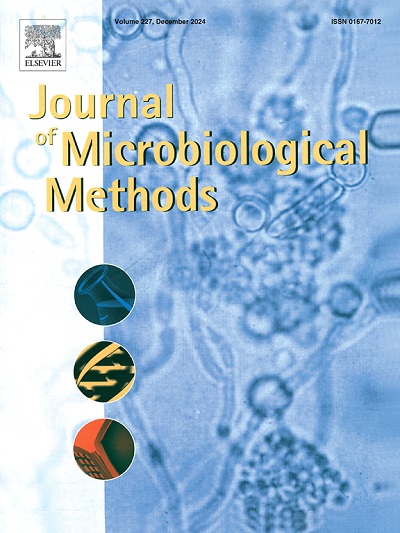Hepcidin vs原降钙素:哪种生物标志物最能预测ICU的菌血症?
IF 1.9
4区 生物学
Q4 BIOCHEMICAL RESEARCH METHODS
引用次数: 0
摘要
背景:脓毒症是由宿主对感染反应失调引起的一种危及生命的疾病,需要早期诊断和干预。虽然血液培养等传统诊断方法至关重要,但它们往往会延误治疗决定。本研究评估并比较了降钙素原(PCT)和hepctin这两种新兴的生物标志物在三级医疗中心重症监护室(MICU)住院的菌血症患者中的诊断和预后效果。方法:对金奈SRM医学院附属医院及研究中心86例血培养阳性的MICU患者进行前瞻性分析研究。采用化学发光微粒免疫分析法(CMIA)和夹心ELISA技术分别测定血清PCT和Hepcidin水平。结果:84.8% %和82.6% %的脓毒症患者血清Hepcidin和PCT水平升高,具有统计学意义(p )。结论:Hepcidin作为一种有前景的生物标志物,显示出与PCT相当的诊断和预后潜力,在脓毒症消退期间具有更一致的反应。当结合使用时,这些标志物可以加强早期发现,指导治疗,并改善败血症管理的临床结果。本文章由计算机程序翻译,如有差异,请以英文原文为准。
Hepcidin vs Procalcitonin: Which biomarker best predicts bacteremia in the medical ICU?
Background
Sepsis is a life-threatening condition caused by a dysregulated host response to infection, necessitating early diagnosis and intervention. While traditional diagnostics like blood cultures are crucial, they often delay treatment decisions. This study evaluates and compares the diagnostic and prognostic efficacy of Procalcitonin (PCT) and Hepcidin—two emerging biomarkers—in patients with bacteremia admitted to the Medical Intensive Care Unit (MICU) of a tertiary care centre.
Methods
A prospective, analytical study was conducted on 86 blood culture-positive MICU patients at SRM Medical College Hospital and Research Centre, Chennai. Serum PCT and Hepcidin levels were measured using Chemiluminescent Microparticle Immunoassay (CMIA) and sandwich ELISA techniques, respectively. The diagnostic value of each biomarker was assessed, and statistical analysis was performed using Chi-square tests with p < 0.05 considered significant.
Results
Serum Hepcidin and PCT levels were elevated in 84.8 % and 82.6 % of sepsis patients, respectively, with statistically significant associations (p < 0.05). Hepcidin showed a more consistent and gradual decline during recovery (96 % normalization) compared to PCT (77 % normalization). Both biomarkers correlated strongly with microbial profiles, particularly in Gram-negative infections, and demonstrated no significant variation with patient demographics or comorbidities.
Conclusion
Hepcidin emerges as a promising biomarker, demonstrating diagnostic and prognostic potential comparable to PCT, with a more consistent response during sepsis resolution. When used in conjunction, these markers can enhance early detection, guide treatment, and improve clinical outcomes in sepsis management.
求助全文
通过发布文献求助,成功后即可免费获取论文全文。
去求助
来源期刊

Journal of microbiological methods
生物-生化研究方法
CiteScore
4.30
自引率
4.50%
发文量
151
审稿时长
29 days
期刊介绍:
The Journal of Microbiological Methods publishes scholarly and original articles, notes and review articles. These articles must include novel and/or state-of-the-art methods, or significant improvements to existing methods. Novel and innovative applications of current methods that are validated and useful will also be published. JMM strives for scholarship, innovation and excellence. This demands scientific rigour, the best available methods and technologies, correctly replicated experiments/tests, the inclusion of proper controls, calibrations, and the correct statistical analysis. The presentation of the data must support the interpretation of the method/approach.
All aspects of microbiology are covered, except virology. These include agricultural microbiology, applied and environmental microbiology, bioassays, bioinformatics, biotechnology, biochemical microbiology, clinical microbiology, diagnostics, food monitoring and quality control microbiology, microbial genetics and genomics, geomicrobiology, microbiome methods regardless of habitat, high through-put sequencing methods and analysis, microbial pathogenesis and host responses, metabolomics, metagenomics, metaproteomics, microbial ecology and diversity, microbial physiology, microbial ultra-structure, microscopic and imaging methods, molecular microbiology, mycology, novel mathematical microbiology and modelling, parasitology, plant-microbe interactions, protein markers/profiles, proteomics, pyrosequencing, public health microbiology, radioisotopes applied to microbiology, robotics applied to microbiological methods,rumen microbiology, microbiological methods for space missions and extreme environments, sampling methods and samplers, soil and sediment microbiology, transcriptomics, veterinary microbiology, sero-diagnostics and typing/identification.
 求助内容:
求助内容: 应助结果提醒方式:
应助结果提醒方式:


